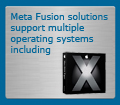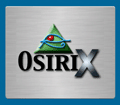| 
Understanding the features
DICOM IMAGE STORAGE CAPACITY
The MetaProxy R5-1 starts with just over 1 TB
of disk space available to store DICOM images
& medical information.
AUTONOMOUS SERVICE COUNT
This value represents the number of DICOM storage
services that are run when the MetaProxy comes
on line. This number is configured as a factory
default value only, and does not represents
the actual capabilities of a MetaProxy under
heavy loads.
DICOM STORAGE & RETRIEVAL
The MetaProxy R5-1 has the ability to accept
DICOM images for storage, and to transmit DICOM
images located in its storage. The specific
DICOM 'commands' that are supported by the device
are described in the device Conformance Statement.
PATIENT, STUDY & IMAGE-LEVEL ACCESS
When using the MetaProxy R5-1, a requestor of
DICOM images can request that the MetaProxy
identify the individual images that it has in
storage, and send individual images. Alternately,
a requestor of DICOM images can request that
the MetaProxy identify and transmit the studies
that it has in storage, where each study consists
of a grouping of images for a particular patient.
Alternately, a requestor of DICOM images can
request that the MetaProxy identify and transmit
the patients for which it has studies in storage,
where each patient can have a grouping of studies
in the store.
AUTO-PULL CAPABILITY FROM MODALITIES
The MetaProxy R5-1 can be configured to automatically
request and pull images from your modalities
for storage & distribution.
DICOM MODALITY WORKLISTS
The MetaProxy 500 has the ability to interact
with imaging modalities that support DICOM worklists.
Imaging modalities can obtain scheduled procedure
information from the MetaProxy 500 and communicate
performed procedure information to it, in compliance
with the DICOM standard.
IMAGE QA AND DICOM EDITOR
The MetaProxy allows the modality technician
to accept or reject images according to their
quality to control their availability to end
users via the MetaProxy. Additionally, the technician
can use the DICOM editor to modify header information
that is missing or erroneously populated prior
to publication.
SECURE CONNECTIVITY WITH VPN
The MetaProxy has Virtual Private Network (VPN)
capability built into it. To protect against
hostile or unauthorized access to protected
information, and in order to provide security
and privacy of medical information under HIPAA,
as a standard rule, the MetaProxy R5-1 operates
in a mode where data is encapsulated & passed
over encrypted channels. VPN secure tunnels
are typically used with those networks that
have endpoints that require transmission over
non-secure or public networks, such as the internet.
Non-encrypted traffic typically is used on networks
secured by Meta Fusion.
WIRE-SPEED VPN CONNECTIVITY
Meta Fusion typically combines the MetaProxy
with external VPN hardware to add more value
to customer networks. Meta Fusion tunes the
VPN performance to match the network peformance
and the performance of the communicating devices.
In a tuned system, the data stream entering
a VPN exits the VPN at the same rate as the
input in order to ensure that the flow of information
is not slowed down by the VPN. This approach
provides a considerable performance benefit
under load as compared to a software VPN implementation.
EMBEDDED FIREWALL
Meta Fusion treats healthcare facilities and
their networks as inherently non-secure hostile
environments. The firewall built into each Meta
Fusion storage product is configured by Meta
Fusion to provide attack hardiness and response,
and prevent the loss or unauthorized access
to the information that we store. In the event
that the facility's network is compromised,
Meta Fusion relies on its own defenses to protect
private valuable medical information. Where
appropriate, Meta Fusion promotes the use of
its networks and its network services to healthcare
customers for implementation of networks according
to best practices and highest standards of security.
WEB ACCESS WITH SSL SECURITY
The MetaProxy comes with a built-in secure
web server. This web server is configurable,
and can be made compatible with internal firewalls.
The web server allows authorized users to connect
remotely to the MetaProxy and request DICOM
images in storage. Secure Socket Layer (SSL)
security provides the standard degree of security
in common use today.
META FUSION FAULT-TOLERANT KERNEL
The Meta Fusion fault-tolerant kernel ensures
that in the event of a diaster, such as the
total loss of a susbsystem, the system will
continue to operate, without interruption, and
that it will be able to maintain this operation
as long as necessary to repair or replace the
destroyed subsystem. No human intervention is
necesary and the Meta Fusion fault-tolerant
kernel detects and compensates for faults and
failures automatically. The Meta Fusion fault-tolerant
kernel provides unique reliability benefits
for multi-hospital groups whose member hoispitals
are separated by (large) geographic distances.
MULTI-NETWORK CAPABILITY
Every MetaProxy has the capability of simultaneously
receiving and serving images on multiple independent
networks. The MetaProxy R5-1 is able to provide
DICOM storage & retrieval services on twelve
directly connected independent 10/100/1000 Mbit/sec
Ethernet netwokrs at one time. Meta Fusion configures
and monitors the MetaProxy device to ensure
that its presence on one or more networks does
not create security vulnerabilities on each
network.
MULTI-BROADBAND CONNECTIVITY
Meta Fusion provides the means to use DSL instead
of T1 lines and achieve equal or higher reliability
and equal or superior bandwidth for a lower
price.
DVD ARCHIVE CAPABILITY
The MetaProxy comes fitted as standard with
multiple DVD writers. This is provided for the
purposes of archiving images to a media that
can be removed to another location for further
disaster resilience. For greater convenience
and better disaster planning, Meta Fusion recommends
the use of a MetaProxy R5-1n conjunction with
your MetaProxy.
STORAGE EXPANSION
A large amount of additional storage capacity
may be added to a MetaProxy. Our filesystem
is well suited to storing and retrieving numerous
images. Meta Fusion recommends the use of a
MetaArchive in conjunction with your MetaProxy.
As most return visits occur within 18 months,
a MetaProxy can be sized to your facility to
provide an 18 month store, and studies may be
archived to your MetaArchive for persistence
and rapid acces over 7+ years.
ROUTING ENGINE
A powerful rules engine is embedded into the
MetaProxy. The routing engine assures delivery
of images to where they are needed. According
to configuration of a rich set of rules, each
image that is received or transmitted by the
MetaProxy can be handled according to programmed
rules. The MetaProxy routing engine can support
a large number of end users simultanously, and
it allows for customization of rules to suit
individual users' requirements.
INTEGRATED WORKFLOW ENGINE
Meta Fusion provides a rule-based configurable
mechanism to assist in managing your imaging
department workflow, including communications
and prompts to ensure that members of your team
respond timely and keep close track of patients
and their tasks.
REMOTE MANAGEMENT
From an end-user point of view, each MetaProxy
is intended to be operated as a zero-maintenance
appliance. The management of the device is performed
remotely in most cases.
SELF-DIAGNOSIS & CERTIFICATION
The MetaProxy continuously performs self-checks
to ensure correct operation & reports anticipated
and actual problems. Each MetaProxy can also
be tied to Meta Fusion's operations infrastructure
whereby it is continuously monitored by external
agents that report on its health, correct function,
regulatory compliance and raise alarms to initiate
rapid response in the event of actual or anticipated
non-conformant behavior.
HIPAA AUDITOR
The MetaProxy supports a 'transparent mode'
that allows an auditor process to evaluate the
HIPAA compliance of the device as it operates,
and according to the device operation logs.
The verified HIPAA audit report is securely
archived.
HIPAA LOGGING
As standard, the MetaProxy keeps detailed logs
of its operation, including tracking every image
access and attempts to access images. These
logs are saved, and offloaded for signing by
Meta Fusion.
STORAGE MANAGEMENT
Each MetaProxy provides built-in storage management
rules that may be activated or de-activated
under suthorized user control. These storage
rules provide for immediate or delayed storage
ageing, clean-up and optimization. When automatic
ageing criteria are configured, the MetaProxy
can perform its functions for extended periods
of time without requiring any administration.
ACCESS CONTROL LISTS
MetaProxy strictly controls access by users
according to a list of authorized entities.
Users that are not on the access control list
are denied access to the MetaProxy.
SWITCHABLE COMPRESSION
Meta Fusion provides a mechanism to add compression
to your image transfer and storage in a MetaProxy.
The compression may be switched on and off.
Reversible and irreversible compression are
possible.
METERING OF STUDIES
The MetaProxy can track the number of individual
accesses by end users to patient studies, and
provide a verified report of these accesses
upon demand. This feature is very useful for
usage-based billing.
DICTATION & TRANSCRIPT STORE
The MetaProxy provides a dictation & transcript
store with association to the patient study
that is the subject of the diagnosis. Dictation
files and diagnosis transcripts can be uploaded
to the MetaProxy automatically by means of a
secure web interface.
EMBEDDED mini-RIS
A feature-limited version of the MetaRIS
radiology information system is integrated with
the MetaProxy for the convenience of the smaller
clinic.
HL-7 INTERFACE
The MetaProxy provides an HL-7 interface capability
by means of which a RIS or a HIS or other information
system may be integrated with the MetaProxy.
METAFUSION MCDP PROTOCOL
Meta Fusion Collaborative Diagnosis Protocol
(MCDP)
METAFUSION MDSIP PROTOCOL
Meta Fusion Server Interaction Protocol (MDSIP)
is used to provide seamless integration when
many hospitals each with one or more MetaProxys
combine to provide continuity of care and access
to patient historical records independently
of geographic location.
RAID
RAID (redundant array of independent disks;
originally redundant array of inexpensive disks)
uses a group of disks to store data in a way
that if one disk fails, the data that was on
the failed disk can be recovered from other
disks. In the more commonplace RAID configurations,
this failure can be tolerated once and if another
disk fails, the data is lost. A RAID appears
to the operating system to be a single logical
hard disk. In some RAID configurations, I/O
(input/output) operations can overlap in a balanced
way, improving performance. In reliability calculations,
having multiple disks can in some cases increase
the mean time between failures (MTBF), and in
these cases, data redundancy achieved with RAID
is considered to increase fault tolerance. However,
the common mistake made by many people is that
RAID is sufficient for high-reliability and
high-availability. In fact, RAID is a feature
that does not necessarily result in the highest
reliabilty or the highest availability. Sometimes
a system can have higher availability and higher
reliability without RAID. Meta Fusion designs
systems that achieve the highest relaibility
and the highest availability, and selectively
uses RAID as a feature when its best design
practices warrant its use.
|



